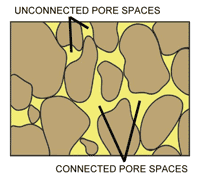A Primer on Finding & Producing Oil & Gas
Crude Oil and Natural Gas are known as hydrocarbons. Hydrocarbons are found in certain layers of rock that are usually buried deep beneath the surface of the earth. In order for a rock layer to qualify as a good source of hydrocarbons, it must meet certain requirements.
Characteristics of Reservoir Rock
A Reservoir is a formation that contains hydrocarbons. For hydrocarbons to be economically extracted from reservoir rock they must exhibit the characteristics of porosity and permeability.
Porosity is a measure of the openings in a rock. These openings allow the possibility for petroleum to exist in the rock’s pores. To the naked eye reservoir rock appears solid yet an examination of the rock on a microscopic level reveals gaps, or pores (Figure 1) throughout the rock. A measure of a rock’s porosity determines the size and/or number of pores in the rock formation which can be an indicator of how much Oil & Gas may be present inside the rock.
Even if a rock is porous it may not be a good candidate for extraction unless it also exhibits permeability. Permeability is a measure of how easily fluids & gas can move through a rock formation. Permeability happens when the pores of the rock are connected together so that hydrocarbons can move from one pore to another (Figure 2). If hydrocarbons cannot move and flow from pore to pore the hydrocarbons remain locked in place and cannot flow into a well.
Porosity and permeability are not the whole story. To explain let’s examine the source of hydrocarbons. The story begins millions of years ago in the very ancient past.

Figure 1

Figure 2
Millions of years ago the seas of the Earth were similar to the way they are today. Although from the surface the sea may appear to be tranquil, below the surface there is a constant fight for life amongst the varied denizens of the deep. Countless millions of sea creatures and microscopic organisms eat and are eaten and die. The remains of these organisms fall as a constant rain of organic matter that accumulates on the sea floor in enormous quantities. The remains form an ooze that mixes with sand on the ocean floor.
Layer upon layer of sediments build up as the millennia pass. Those buried the deepest undergo a transition; they are transformed into rock. The heat and the tremendous weight and pressure of the overlying sediments cause the sediment to change slowly into hydrocarbons. The forces behind the change are not fully understood even today.
Over the years while petroleum was being formed, the Earth’s surface was racked by earthquakes. Huge cracks were opened in the Earth’s surface and under the sea as faultlines slipped. Layers of rock were folded upward and downward. Some formations were exposed to wind and water erosion before being once again buried. The Earth’s very surface had been changed.
Hydrocarbons that had been formed lay cradled in their source rocks. With the movement of continental plates and the tremendous weight of overlying rocks and sediments the hydrocarbons of the deep ocean were pushed into new locations. Seeping through fissures and oozing through the pores in neighboring rocks hydrocarbons began a journey upward taking millions of years. Though some petroleum made it’s way to the surface of the Earth creating pools of tar, much of it was trapped far beneath the surface by impervious rock formations.
Today’s Oil producers seek out the locations of these rock formations known as traps where hydrocarbons lie in wait to be retrieved.
Layer upon layer of sediments build up as the millennia pass. Those buried the deepest undergo a transition; they are transformed into rock. The heat and the tremendous weight and pressure of the overlying sediments cause the sediment to change slowly into hydrocarbons. The forces behind the change are not fully understood even today.


